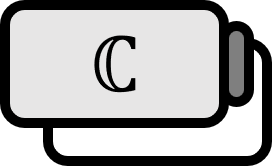Schwarz-Christoffel Mapping
Theorem 1

On the complex plane, a polygon with $n$ angles is called $\mathscr{P}$, and let’s denote these angles as $w_{r}$ and the size of its interior angles as $\psi_{r}$. Then, for $K, C, z_{0} \in \mathbb{C}$ and $x_{r} \in \mathbb{R}$, the transformation that satisfies $f(x_{r}) = w_{r}$ $$ w = f(z) = K \int_{z_{0}}^{z} \prod_{r = 1}^{n} ( \zeta - x_{r})^{ \psi_{r} / \pi - 1 } d \zeta + C $$ maps the real axis to the broken line $\mathscr{P}$. This is called the Schwarz-Christoffel Transformation.
Explanation
If we assume $z_{0} = 0$, this is represented as a mapping on $|z|=1$, the unit circle, for $z_{1} , \cdots , z_{n}$. The proof is omitted because it’s too long and tedious, but to get a rough idea, $f '$ is by the Fundamental Theorem of Calculus $$ f ' (z) = K \prod_{r=1}^{n} (z - x_{r})^{\psi_{r} / \pi - 1} $$ and, $f ' (x_{r}) = 0$, i.e., the presence of critical points can be confirmed.
Understanding the geometric meaning of critical points, it would not be difficult to guess how such a function was discovered. Since it obviously includes polygons when we say broken lines, its importance needs no further discussion.
If $\mathscr{P}$ is a polygon, note that points satisfying $\operatorname{Im} z > 0$, that is, the upper side of the $Z$-plane, correspond to the interior of $\mathscr{P}$. Surprisingly, even cases like $x_{n} = \infty$ are permissible and if we set as $K = K ' ( - x_{n})^{- \alpha_{n}}$ $$ f(z) = K ' \int_{z_{0}}^{z} \prod_{r = 1}^{n-1} ( \zeta - x_{r})^{ \psi_{r} / \pi - 1 } \left( 1 - {{ \zeta } \over { x_{n} }} \right)^{\psi_{n} / \pi - 1} d \zeta + C $$ since $\displaystyle \lim_{x_{n} \to \infty} \left( 1 - {{ \zeta } \over { x_{n} }} \right) = 1$, it can just be considered nonexistent.
Osborne (1999). Complex variables and their applications: p225. ↩︎
